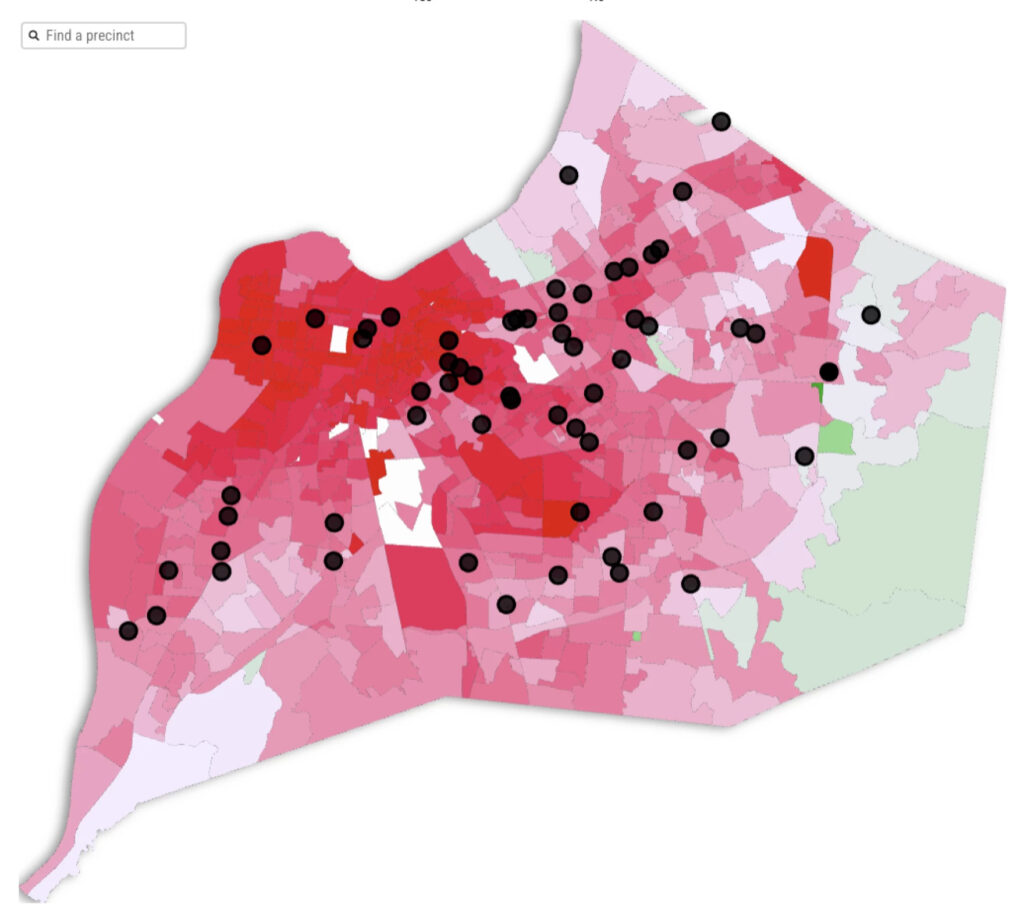
More than half of all certified private schools in the state are located in just three of Kentucky’s counties: Jefferson, Fayette and Kenton. Some supporters of Amendment 2, which would have allowed the state legislature to spend state money on private or charter education, were hoping those counties would support the ballot initiative.
But even in those three counties, where parents could foreseeably take advantage of the kind of school choice programs put forward by “school choice” advocates, few precincts voted for the amendment. In Fayette county, not one voting precinct supported the amendment. In both Jefferson and Kenton counties, only a few precincts voted in favor of the amendment, but often by small margins and in small precincts.
It’s a trend repeated across the state. Not one Kentucky county voted in favor of the amendment; it failed with nearly 65% of Kentucky voters saying “no.”
In Jefferson County, just over a dozen precincts out of 627 voted in support of the amendment. In the city’s downtown and West End, which has been a target of the GOP-controlled legislature, the amendment failed by astounding margins — as much as 89% of voters in a precinct said “no” to Amendment 2. All but one of the precincts that came out in support of the ballot initiative were located in the county’s East End.
Proximity to private schools also didn’t seem to sway voters toward the “school choice” amendment. Tres Watson, a Kentucky political consultant and former GOP spokesperson, said he wasn’t surprised to see the amendment flounder even in urban areas, although he didn’t predict the wide margins.
“When you look across the country where a similar law changes, or states that have similar capabilities in their laws, charter schools tend to be the more successful and more popular usage of that law in urban areas,” Watson said.
Anti-Amendment 2 messaging focused largely on the possibility of school vouchers, calling it the “voucher amendment.” Watson said supporters of the amendment were hoping potential access to private schools would be a selling point for people in the state’s urban areas.
But he believes charter schools could have been more appealing to Louisvillians, as several major blue cities, like New York City, Chicago and Philadelphia, have a longstanding charter school system.
The General Assembly passed a 2022 law that would have required school districts to divert funding to approved charter schools, but a circuit court judge found the funding mechanism unconstitutional.
Watson said he expects to see fresh movement on that lawsuit and more emphasis put on public charters, despite the amendment’s failure.
Opponents of Amendment 2 in many ways framed it as a referendum on public schools — voting “yes,” they argued, could lead to decreased funding for the institutions that educate the vast majority of Kentuckians.
Michelle Pennix, a former JCPS principal and education consultant, said she believed the resounding “no” on Amendment 2 was a “vote of confidence” in kids and the concept of a public education.
“They know it’s not perfect,” Pennix said. “They understand why many of our systems are failing us, and as a result, are not placing the blame squarely at JCPS.”
Jefferson County Public Schools have been a frequent target of the state legislature. Republicans have threatened a state takeover of the state’s largest school district and discussed breaking up the school district.
The day after the election, GOP Senate President Robert Stivers of Manchester said the amendment’s opponents didn’t accurately describe the legislature’s intentions, which he said was to help the “poorest and the most needy” students, specifically identifying Louisville’s West End.
But in that very area of Louisville, voters overwhelmingly rejected the amendment. Pennix said she was “skeptical” the amendment would have benefitted families in west Louisville. Most Louisville private schools are concentrated on the other side of town.
“I’d like to Robert Stivers and all of the Republicans in our legislature to outlay what are the things that they’ve done for the people and the families and the children in west Louisville, besides offer up this amendment that ultimately would have moved students from west Louisville schools and communities out further to even attend private schools,” he said.
Pennix said there’s a long history of “have and have nots” in Louisville and in general in the state. Some felt that a private school education is designed for wealthy students, and that wouldn’t change even if Amendment 2 had passed.
“Most people have sent their children to public schools, and that’s what they know school to be,” Pennix said.
Trump endorsement does little
In a series of ads, a political action committee called Empower Kentucky Parents — which had raised $1.25 million as of mid-October — attempted to tie Amendment 2 to the national presidential campaign. One ad features president-elect Donald Trump telling viewers that he is fully in support of “school choice.”
It says “Kentuckians agree with Donald Trump. If you do too, vote ‘yes’ on two.”
One of the main tenets of Trump’s education platform, aside from dismantling the U.S. Department of Education, is “universal school choice.” But while Amendment 2 invariably failed, Trump expanded his margin of victory in the state’s rural areas over his 2020 presidential run.
In some of the rural counties where Trump had the greatest advantage, Amendment 2 had the least success. For example, in Monroe County along the Tennessee border, Trump won with 89% of the vote. But 70.5% of those same groups of voters rejected Amendment 2. In north-eastern Robertson County, the state’s smallest county, nearly three out of four votes said “no” to the amendment while more than 80% voted for Trump. It’s a trend that repeated in every rural county to varying degrees.
Monroe and Robertson counties, like the majority of Kentucky’s counties, do not have a single certified private school.
Kentucky Public Radio’s Joe Sonka contributed to this reporting.
State government and politics reporting is supported in part by the Corporation for Public Broadcasting.

